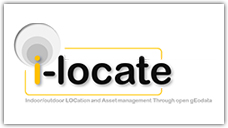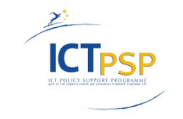
The European project i-locate for indoor/outdoor location of people and equipment through the use of "open" data has started its activities
In a nutshell, the project's objective is to simplify the life of users by helping them "navigate” inside buildings, using their smartphone, to reach their place of destination (e.g. inside a public office, a clinic, a shopping mall, etc.), providing further information available regarding queues, or unforeseen change in schedule. "i-locate" also allows tracking objects and portable equipment within "indoor" spaces to improve their management and maintenance.
"i-locate" is the acronym of "Indoor / outdoor location and Asset Management Through Open Geodata". The project will integrate existing technologies transferring results of pre-existing research already or development into solutions that can be turned into real products.
"i-locate" will last three years starting from 1 January 2014; it has a total budget of 4.7 million Euros and it is being co-financed by the European Commission (through the ICT-PSP programme). The project involves 24 partners located in 9 European countries (Croatia, Great Britain, Germany, Greece, Italy, Luxembourg, Malta, the Netherlands, Romania).

The "i- locate" system is based on the use and integration of different technologies. The challenge is to achieve the following objectives:
1. Creating and publishing a portal for sharing "open data" related to "indoor" spaces, such as railway stations, shopping malls, hospitals etc.
2. Creation of an open source toolkit for interoperable location and "door-to-door" navigation, both in indoor and outdoor contexts, leveraging on various technologies available today (Wi-Fi, GPS, Bluetooth, etc.) in a totally transparent way for the user.
3. Validation of the technologies developed within 13 pilot sites for 18 months with the active involvement of end-users. The use cases that will be explored are of great technological, social and economic relevance, namely:
a) Health Services: "door to door" navigation of patients across a clinical path, from the doorstep at their homes to the door of the room inside the hospital, taking into account dynamic conditions such as the availability of public transport (outside) or queues at the clinic (inside).
b) Public services: door -to-door navigation to public offices (such as the registry office).
c) Cultural tours: guidance during cultural tours that take place both indoors and outdoors.
d) Maintenance scenarios: maintenance engineers can find portable pieces of equipment inside buildings for maintenance activities.
e) Lean management models: sharing devices inside buildings to enable more flexible sharing mechanisms of between different offices, departments etc. based on real-time location of asset.
The project was kicked off on January 22, 2014 at the headquarters of Trentino Sviluppo in Rovereto (Italy), with the first official public event called "Thinkshop" a panel discussion on the main issues to be addressed in the "i-locate". The event was thought as a "collective brainstorming" and it was joined by key experts in the field of geographic information whose thoughts were stirred by a lively audience of about 70 people.
In the afternoon, the kick-off meeting of the project took place which continued, the following day, by a full day session at the Conference Room of the hospital Santa Maria di Rovereto which is a partner of the pilot project.
The week continued, on Friday, with the participation by the project partners to international conference "INNOVANDO” on new projects and technological solutions for Health and Social Care, which was organized by the HIH (Health Innovation Hub ) consortium at the conference hall of Trentino Sviluppo in Rovereto, Italy. Partners and advisors of "i- locate" gave three keynotes, each bringing their own experience and their own point of view in terms of technological innovation and ICT innovation in the field of social and health care.
At the end of each of day, in order to promote teambuilding, Trilogis organized several events including a guided tour of the Cesarini Sforza winery and a guided tour of the new museum of natural science MUSE. The project partners had the chance to enjoy a private visit of the museum (specifically kept open for the event) and have a video conference call with Patrick Hogan of NASA, member of the Advisory Board of the project, which illustrated the potential of using 3D geovisualisation solution World Wind within i-locate.




